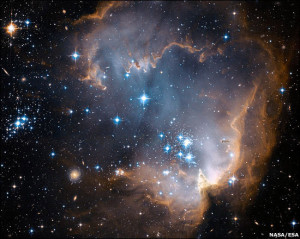Many Changes to the Laws of Physics Would be Life-Prohibiting
In my previous blog, I discussed how the initial conditions of our universe had to be extremely finely-tuned to support life of any kind anywhere in the universe. As part of my ongoing series on how fine-tuning provides evidence for the existence of God, I now turn to the laws of physics themselves. It turns out that life seems to require all 4 fundamental forces of physics. Let’s do a quick survey of some of the many ways that alternate physics could have been life-prohibiting:
1) Gravity is essential in the formation of stars and planets. As I discussed in a previous blog, life needs something like stars as a long-lived stable energy source. Also, as cosmologist Luke Barnes has pointed out: “if gravity were repulsive rather than attractive, then matter wouldn’t clump into complex structures. Remember: your density, thank gravity, is 1030 times greater than the average density of the universe.”
2) The strong nuclear force is necessary to hold together the protons and neutrons in the nucleus. Without this fundamental force, no atoms would exist beyond hydrogen and thus there would be no meaningful chemistry and thus no possibility for intelligent life. The positively charged protons in the nucleus repel each other but thankfully the strong nuclear force is sufficiently stronger than electromagnetic repulsion. If the strong force acted at long ranges like gravity or electromagnetism, then no atoms would exist because it would dominate over the other forces. Barnes notes that “any structures that formed would be uniform, spherical, undifferentiated lumps, of arbitrary size and incapable of complexity.[1]”
3) The electromagnetic force accounts for chemical bonding and for why electrons orbit the nucleus of atoms. Without chemistry, there is no plausible way to store and replicate information such as would be necessary for life. Light supplied by stars is also of critical importance to life in overcoming the tendency towards disorder, as dictated by the Second Law of Thermodynamics. Barnes points out that without electromagnetism, “all matter would be like dark matter, which can only form large, diffuse, roughly spherical haloes.[2]” Suppose like charges attracted and opposites repelled (in contrast with the behavior in our universe), there would be no atoms.
4) The weak nuclear force plays a key role during core-collapse supernova[3] in the expulsion of key heavier elements, making them available for life rather than just entombed forever in dying stars. Also, the weak force enables the key proton-proton reaction which powers stars in our universe. There is a clever paper by Harnik[4] that attempts to find a life-permitting universe without the weak force but only at the expense of a “judicious parameter adjustment.” See this discussion of the additional finely-tuned constants that were necessary to compensate for the lack of a weak force.[5] Also, some physicists think that the weak force is necessary for there to be matter in our universe.[6]
A region of star formation in a small nearby dwarf galaxy (N90) as captured by the Hubble telescope:

The existence of matter in our universe relies on some asymmetries in physics that are not yet precisely understood. Most physical reactions produce matter and antimatter in equal proportions and these products would simply annihilate each other upon contact, resulting in a matter-less (and therefore lifeless) universe consisting solely of radiation. We’re fortunate that the laws are such that this asymmetry produces a slight excess of matter over antimatter (about 1 part in ten billion)[7]! It would be premature to try to make a numerical claim that a constant has to be finely-tuned to permit this phenomenon but this unusual asymmetry provides yet another example of how different physics could have been catastrophic for life.
Another key physics principle that is critical for life is quantization. Values are defined as being ‘quantized’ if they can only take on discrete rather than continuous possibilities. Without quantized orbits electrons would be sucked into the nucleus and no chemistry would be possible. This quantization also leads to stable orbitals and consistent chemical properties. If electrons could orbit the nucleus anywhere such as is permissible for planets orbiting a star, then a given chemical element would have properties which are too variable for information storage of the type needed for intelligent life. Consider how the DNA in your genome would become cancerous within a day if its properties/information content were constantly varying. Also, consider how a breath of oxygen could conceivably become poisonous if its properties had no consistency.
Some other aspects of quantum mechanics are also very important to life. We need the Pauli Exclusion Principle so that all electrons don’t just reside in the lowest energy-level orbital. The multiple levels of orbitals contribute greatly to the richness and diversity of chemistry. Not all types of particles follow the Pauli Exclusion Principle – if electrons were bosons rather than fermions they wouldn’t be restricted by this principle. The Pauli Exclusion Principle coupled with the quantization of electron orbitals is responsible for giving matter its rigidity, which is important for the existence of stable structures. Moreover, without quantum mechanics, atoms would decay in about 10-13 seconds as Earnshaw’s theorem demonstrates based on classical mechanics.
Physicist Leonard Susskind points out yet another way that physics could have been life-prohibiting:
‘The photon is very exceptional. It is the only elementary particle, other than the graviton, that has no mass… Were the photon mass even a tiny fraction of the electron mass, instead of being a long-range force, electric interactions would become short-range “flypaper forces,” totally incapable of holding on to the distant valence electrons. Atoms, molecules and life are entirely dependent on the curious fact that the photon has no mass.[8]’
The trend in physics is that the number of cases of fine-tuning is growing over time. For example, physicist Joel Primack recently discovered an important link between the existence of dark matter and galaxy formation. Primack showed that “galaxies form only at high peaks of the dark matter density.“ Galaxies are generally thought to be necessary for life because they are critical for star formation. Thus, even aspects of physics which might seem pointless, such as dark matter, turn out to play an important role in making the universe more bio-friendly. I’ve also referenced an article in a previous blog that discusses how black holes “may actually account for Earth’s existence and habitability.[9]”
Any one of these facts by itself might just be seen as fortunate coincidences but there are enough of them to provide at least modest support for my fine-tuning claim:
“In the set of possible physical laws, parameters and initial conditions, the subset that permits rational conscious life is very small.”
The support is not as strong as what I documented based on our universe’s initial conditions nor as strong as what I will document concerning the fine-tuning of the constants of nature but it adds to the overall case. Moreover, this evidence has some bearing in the consideration of the multiverse[10] as an explanation of fine-tuning because it deals with physics at the level that most multiverse proposals cannot explain. In most multiverse scenarios the laws of physics are the same – what changes are the constants in the equations representing those laws. If you want to explore more about various multiverse alternatives, here is one useful perspective that was referenced in comments of a previous blog. Max Tegmark has proposed what he calls a level 4 multiverse in which all mathematical possibilities are realized somewhere in the multiverse. If we lived in such a multiverse, Occam’s Razor would not be a fruitful heuristic and we wouldn’t have Nobel laureates[11] talking about how simple, elegant theories led them to discoveries. There would be infinitely more equations with lots of complicated terms and expressions than there would be simple equations with minimal terms. Colombia professor Peter Woit provides a powerful critique of Tegmark’s highly speculative metaphysical proposal. These multiverse scenarios in which fundamental laws are different are not widely accepted among physicists.
In summary, life needs all of the 4 fundamental forces of nature and several principles from quantum mechanics. These facts about the laws support my fine-tuning claim that life-permitting physics is rare among possibilities. Standford physicist Leonard Susskind summarizes the physics well:
“It is gradually becoming accepted, by many theoretical physicists, that the Laws of Physics may not only be variable but are almost always deadly. In a sense the laws of nature are like East Coast weather: tremendously variable, almost always awful, but on rare occasions, perfectly lovely.[12]”
[1] Barnes, Luke. The Fine-Tuning of the Universe for Intelligent Life. Publications of the Astronomical Society of Australia, p. 18. http://arxiv.org/abs/1112.4647
[2] Ibid., p, 18.
[3] A supernova is an exploding star and is the key way heavy elements are distributed throughout the universe.
[4]Harnik R., Kribs G., Perez G., 2006, Physical Review D, 74, 035006
[5]Barnes, p. 46-7.
[6] Fermilab website. DOE. http://lbne.fnal.gov/why-neutrinos.shtml
[7] Here is a website if you want to explore this further: http://abyss.uoregon.edu/~js/cosmo/lectures/lec22.html
[8] Susskind, Leonard. The Cosmic Landscape, p. 174-5.
[9] http://www.scientificamerican.com/article/how-black-holes-shape-galaxies-stars-planets-around-them/
[10] If you missed my other blogs and are wondering what a ‘multiverse’ is, a multiverse is simply a collection of universes. If there is a vast ensemble of other universes with widely varying laws this might be a candidate explanation of the fine-tuning. Here was my blog on that topic: http://crossexamined.org/god-or-multiverse/
[11] For example, Eugene Wigner’s famous essay on The Unreasonable Effectiveness of Mathematics in the Natural Sciences. https://www.dartmouth.edu/~matc/MathDrama/reading/Wigner.html. Also, see how Weinberg regards beauty as a guide to finding the correct physical theories: http://www.pbs.org/wgbh/nova/elegant/view-weinberg.html. Or refer to this essay for a historical review: http://www.huffingtonpost.com/david-h-bailey/why-mathematics-matters_b_4794617.html
[12] Susskind, p. 90.












Leave a Reply
Want to join the discussion?Feel free to contribute!